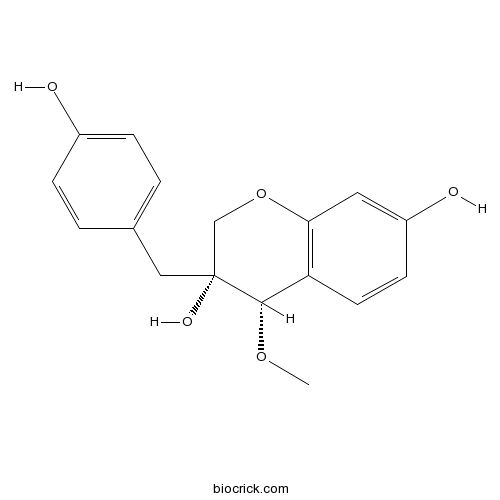3'-Deoxy-4-O-methylsappanolCAS# 112408-68-1 |

- 3'-Deoxy-4-O-methylepisappanol
Catalog No.:BCN3676
CAS No.:1052714-12-1
Quality Control & MSDS
3D structure
Package In Stock
Number of papers citing our products

| Cas No. | 112408-68-1 | SDF | Download SDF |
| PubChem ID | 13846680 | Appearance | Powder |
| Formula | C17H18O5 | M.Wt | 302.3 |
| Type of Compound | Flavonoids | Storage | Desiccate at -20°C |
| Solubility | Soluble in Chloroform,Dichloromethane,Ethyl Acetate,DMSO,Acetone,etc. | ||
| Chemical Name | (3R,4S)-3-[(4-hydroxyphenyl)methyl]-4-methoxy-2,4-dihydrochromene-3,7-diol | ||
| SMILES | COC1C2=C(C=C(C=C2)O)OCC1(CC3=CC=C(C=C3)O)O | ||
| Standard InChIKey | NRDMATSOBGRQDO-DLBZAZTESA-N | ||
| General tips | For obtaining a higher solubility , please warm the tube at 37 ℃ and shake it in the ultrasonic bath for a while.Stock solution can be stored below -20℃ for several months. We recommend that you prepare and use the solution on the same day. However, if the test schedule requires, the stock solutions can be prepared in advance, and the stock solution must be sealed and stored below -20℃. In general, the stock solution can be kept for several months. Before use, we recommend that you leave the vial at room temperature for at least an hour before opening it. |
||
| About Packaging | 1. The packaging of the product may be reversed during transportation, cause the high purity compounds to adhere to the neck or cap of the vial.Take the vail out of its packaging and shake gently until the compounds fall to the bottom of the vial. 2. For liquid products, please centrifuge at 500xg to gather the liquid to the bottom of the vial. 3. Try to avoid loss or contamination during the experiment. |
||
| Shipping Condition | Packaging according to customer requirements(5mg, 10mg, 20mg and more). Ship via FedEx, DHL, UPS, EMS or other couriers with RT, or blue ice upon request. | ||
| Description | 1. 3'-Deoxy-4-O-methylsappanol shows moderate cytotoxicities against cultured human melanoma HMV-II cells with the IC50 value of 872.0 uM ± 2.4. |
| Targets | Tyrosinase |

3'-Deoxy-4-O-methylsappanol Dilution Calculator

3'-Deoxy-4-O-methylsappanol Molarity Calculator
| 1 mg | 5 mg | 10 mg | 20 mg | 25 mg | |
| 1 mM | 3.308 mL | 16.5399 mL | 33.0797 mL | 66.1594 mL | 82.6993 mL |
| 5 mM | 0.6616 mL | 3.308 mL | 6.6159 mL | 13.2319 mL | 16.5399 mL |
| 10 mM | 0.3308 mL | 1.654 mL | 3.308 mL | 6.6159 mL | 8.2699 mL |
| 50 mM | 0.0662 mL | 0.3308 mL | 0.6616 mL | 1.3232 mL | 1.654 mL |
| 100 mM | 0.0331 mL | 0.1654 mL | 0.3308 mL | 0.6616 mL | 0.827 mL |
| * Note: If you are in the process of experiment, it's necessary to make the dilution ratios of the samples. The dilution data above is only for reference. Normally, it's can get a better solubility within lower of Concentrations. | |||||

Calcutta University

University of Minnesota

University of Maryland School of Medicine

University of Illinois at Chicago

The Ohio State University

University of Zurich

Harvard University

Colorado State University

Auburn University

Yale University

Worcester Polytechnic Institute

Washington State University

Stanford University

University of Leipzig

Universidade da Beira Interior

The Institute of Cancer Research

Heidelberg University

University of Amsterdam

University of Auckland

TsingHua University

The University of Michigan

Miami University

DRURY University

Jilin University

Fudan University

Wuhan University

Sun Yat-sen University

Universite de Paris

Deemed University

Auckland University

The University of Tokyo

Korea University
- 3-Deoxysappanchalcone
Catalog No.:BCN3736
CAS No.:112408-67-0
- Tetramethylpyrazine
Catalog No.:BCN1008
CAS No.:1124-11-4
- XL765
Catalog No.:BCC2060
CAS No.:1123889-87-1
- DMPQ dihydrochloride
Catalog No.:BCC6977
CAS No.:1123491-15-5
- WAY-262611
Catalog No.:BCC5507
CAS No.:1123231-07-1
- BRL 52537 hydrochloride
Catalog No.:BCC6751
CAS No.:112282-24-3
- H-Asp(OcHex)-OH
Catalog No.:BCC2887
CAS No.:112259-66-2
- 20(R)-Ginsenoside Rh2
Catalog No.:BCN2484
CAS No.:112246-15-8
- (S)-tert-Leucinol
Catalog No.:BCN8367
CAS No.:112245-13-3
- Stigmastane-3,6-diol
Catalog No.:BCN6003
CAS No.:112244-29-8
- 16-O-Methyl-14,15-didehydroisovincanol
Catalog No.:BCN1618
CAS No.:112237-71-5
- 14,15-Didehydrovincamenine
Catalog No.:BCN6002
CAS No.:112219-48-4
- 2',5,7-Trihydroxy-8-methoxyflavanone
Catalog No.:BCN6004
CAS No.:112408-71-6
- Ganoderic acid TN
Catalog No.:BCN2443
CAS No.:112430-64-5
- Ganoderic acid T-Q
Catalog No.:BCN3209
CAS No.:112430-66-7
- Ganoderic acid Jb
Catalog No.:BCN7972
CAS No.:112430-68-9
- AZ3146
Catalog No.:BCC3731
CAS No.:1124329-14-1
- 3-Phenyl-1-(pyrrol-1-yl)propan-1-one
Catalog No.:BCN4005
CAS No.:112448-69-8
- U-54494A hydrochloride
Catalog No.:BCC6668
CAS No.:112465-94-8
- H-Glu(OcHex)-OH
Catalog No.:BCC2929
CAS No.:112471-82-6
- 4,4-Pentamethylenepiperidine hydrochloride
Catalog No.:BCC6059
CAS No.:1125-01-5
- 5-Aminoisoquinoline
Catalog No.:BCC8736
CAS No.:1125-60-6
- 6-Aldehydo-isoophiopogonone A
Catalog No.:BCN6629
CAS No.:112500-90-0
- Aristolactam FI
Catalog No.:BCN6005
CAS No.:112501-42-5
Suppression of melanin synthesis by the phenolic constituents of sappanwood (Caesalpinia sappan).[Pubmed:23154842]
Planta Med. 2013 Jan;79(1):37-44.
Sappanwood (Caesalpinia sappan Linn.) is used as an herbal medicine. It is sometimes used to treat skin damage or as a facial cleanser. In the present study, the methanol (MeOH) extract of sappanwood was found to inhibit melanin synthesis in cultured human melanoma HMV-II cells stimulated with forskolin, and six active compounds (1-5 and 7) were isolated from the extract along with a non-active compound (6). Compounds 2-7 were identified as sappanchalcone (2), 3'-deoxy-4-O-methylsappanol (3), brazilein, (4), brazilin (5), sappanol (6), and 4-O-methylsappanol (7). Compound 1 was a new compound, and its structure was determined to be (6aS,11bR)-7,11b-dihydro-6H-indeno[2,1-c]chromene-3,6a,10,11-tetrol by spectroscopic analyses. Among the six active compounds, brazilin (5) (EC50: 3.0 +/- 0.5 microM) and 4-O-methylsappanol (7) (EC50: 4.6 +/- 0.7 microM) strongly suppressed melanin synthesis in HMV-II cells. Bioactive compounds showed moderate cytotoxicities against HMV-II cells with IC50 values of 83.1 +/- 4.0 microM (for 2), 72.0 microM +/- 2.4 (for 3), 33.8 +/- 1.1 microM (for 4), 18.4 +/- 0.8 microM (for 5), and 20.2 +/- 0.8 (for 7), respectively. Brazilin (5) selectively suppressed the expression of mRNAs for tyrosinase-related protein (TYRP) 2 and tyrosinase but did not influence the expression of TYRP1. These results suggest that brazilin (5) is a new class of melanin inhibitor and that sappanwood could be used as a cosmetic material.


